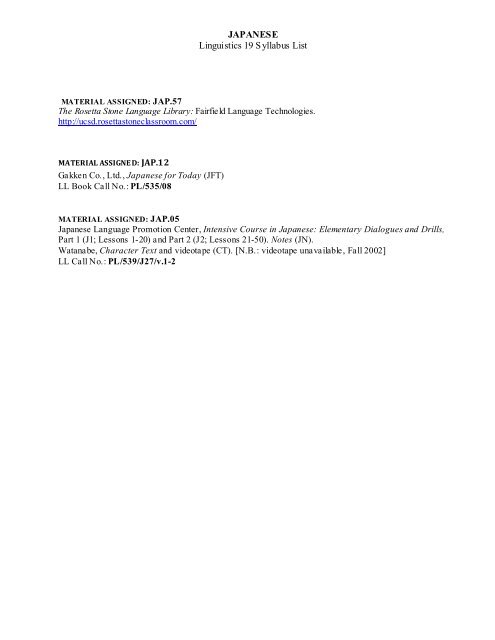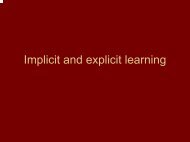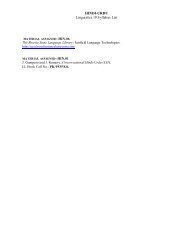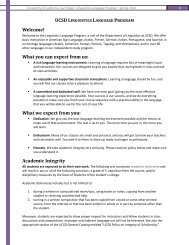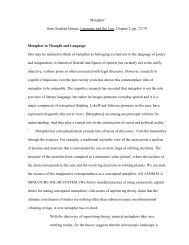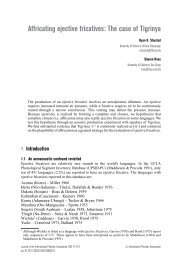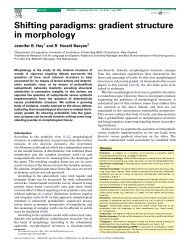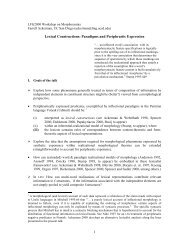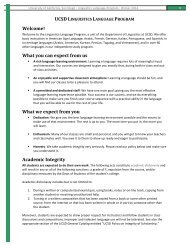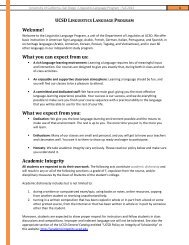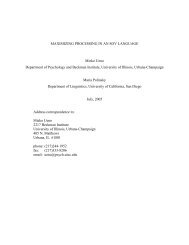JAPANESE (Rosetta Stone) - Linguistics
JAPANESE (Rosetta Stone) - Linguistics
JAPANESE (Rosetta Stone) - Linguistics
You also want an ePaper? Increase the reach of your titles
YUMPU automatically turns print PDFs into web optimized ePapers that Google loves.
<strong>JAPANESE</strong><br />
<strong>Linguistics</strong> 19 S yllabus List<br />
MATERIAL ASSIGNED: JAP.57<br />
The <strong>Rosetta</strong> <strong>Stone</strong> Language Library: Fairfield Language Technologies.<br />
http://ucsd.rosettastoneclassroom.com/<br />
MATERIAL ASSIGNE D: JAP.12<br />
Gakken Co., Ltd., Japanese for Today (JFT)<br />
LL Book Call No.: PL/535/08<br />
MATERIAL ASSIGNED: JAP.05<br />
Japanese Language Promotion Center, Intensive Course in Japanese: Elementary Dialogues and Drills,<br />
Part 1 (J1; Lessons 1-20) and Part 2 (J2; Lessons 21-50). Notes (JN).<br />
Watanabe, Character Text and videotape (CT). [N.B.: videotape unavailable, Fall 2002]<br />
LL Call No.: PL/539/J27/v.1-2
<strong>JAPANESE</strong><br />
<strong>Linguistics</strong> 19 Syllabus<br />
JAP.57 r6<br />
PURPOSE: To develop basic listening and speaking skills.<br />
MATERIAL ASSIGNED: JAP.57<br />
The <strong>Rosetta</strong> <strong>Stone</strong> Language Library: Fairfield Language Technologies.<br />
http://ucsd.rosettastoneclassroom.com/<br />
RESTRICTION: None<br />
MAXIMUM AMOUNT OF CREDIT AVAILABLE: 6 units<br />
METHOD OF STUDY:<br />
Login to <strong>Rosetta</strong> <strong>Stone</strong> website (http://ucsd.rosettastoneclassroom.com/) and orientate yourself to the<br />
program by reading the Quick Start Guide.<br />
Launch <strong>Rosetta</strong> <strong>Stone</strong> and select the appropriate language level.<br />
Select the appropriate unit at the top of the page.<br />
Work through all of the lessons in each unit.<br />
EXAMINATION:<br />
During the examination, the supervisor will login to <strong>Rosetta</strong> <strong>Stone</strong> using a test account. This test account<br />
includes a test component which is not available in the students’ version of <strong>Rosetta</strong> <strong>Stone</strong>. Students will be<br />
tested on materials drawn solely from what they have learnt in their version of <strong>Rosetta</strong> <strong>Stone</strong>; questions that<br />
require reading/writing will not be counted towards the grade. If the student has completed all the lessons<br />
before taking the test, s/he would have encountered all the test questions when going through the lessons.<br />
Students will take 3 short tests for each unit. Each test consists of about 5-10 multiple choice questions.<br />
Every question is weighted equally, and a zero will be given for any question if the student provides an<br />
incorrect answer to any part of the question.<br />
IMPORTANT:<br />
Students must complete all the lessons in the syllabus before taking the final exam. Failure to do so will<br />
lower the course grade by a third of a letter grade (i.e. a ‘B’ will become a ‘B-’).<br />
ASSIGNMENT:<br />
Block 1: Units 1 and 2 (Level 1)<br />
Block 2: Units 3 and 4 (Level 1)<br />
Block 3: Units 1 and 2 (Level 2)<br />
Block 4: Units 3 and 4 (Level 2)<br />
Block 5: Units 1 and 2 (Level 3)<br />
Block 6: Units 3 and 4 (Level 3)<br />
2 Units 4 Units<br />
STUDY TIME= 6 hrs/wk<br />
STUDY TIME= 12 hrs/wk<br />
MIDTERM= First Block<br />
MIDTERM= First 2 Blocks<br />
FINAL= Second Block<br />
FINAL= Next 2 Blocks<br />
Revised 08/02
JAP.12 r9<br />
<strong>JAPANESE</strong><br />
<strong>Linguistics</strong> 19 Syllabus<br />
PURPOSE: Speaking conversational modern Japanese and reading. More emphasis on language use<br />
than on grammar. Course is based on the romanized version of the lessons, though Japanese forms (kanji<br />
and kana) are also shown. Students wanting to be tested on recognition of kanji should use JAP 05.<br />
MATERIAL ASSIGNED: JAP.12<br />
Gakken Co., Ltd., Japanese for Today (JFT)<br />
LL Book Call No.: PL/535/08<br />
RESTRICTION: None<br />
MAXIMUM AMOUNT OF CREDIT AVAILABLE: 8 units<br />
METHOD OF STUDY:<br />
At the beginning of the course, listen twice through the Dialogues to familiarize yourself with the<br />
pronunciation of Japanese. Note that there are 2 dialogues per lesson, several pages apart.<br />
For each dialogue,<br />
1. Listen to the entire dialogue while following the English translation in the book to tell you what the<br />
foreign sentences mean.<br />
2. Listen again while following the foreign transcription to help you with details in the pronunciation.<br />
2. Listen again with the book half-closed—look inside only when you need reminders about the meaning<br />
or pronunciation.<br />
3. Replay individual phrases and say them aloud without referring to the book if possible. Imitate the<br />
voice on tape as closely as you can. Replay and repeat each phrase, then add phrases together to build<br />
a full sentence. Continue to build phrases into sentences in this way, until you can say the complete<br />
sentence easily and in unison with the tape while understanding what you are saying. Use the book only<br />
for occasional reference.<br />
4. Say the sentences of the dialogue along with the speaker on the tape again and again until you can<br />
produce the foreign sentences easily and quickly given only the English ones as cues.<br />
EXAMINATION:<br />
Supervisor says the English version of sentences chosen at random from conversations in the assigned<br />
material; the student says the Japanese equivalent. The grade is based on both fluency and accuracy.<br />
All exams are 30 minutes. Final is not cumulative.<br />
ASSIGNMENT:<br />
<strong>JAPANESE</strong> FOR TODAY (JFT)<br />
Block 1: JFT Lessons 1-4 Block 5: JFT Lessons 17-20<br />
Block 2: JFT Lessons 5-8 Block 6: JFT Lessons 21-24<br />
Block 3: JFT Lessons 9-12 Block 7: JFT Lessons 25-27<br />
Block 4: JFT Lessons 13-16 Block 8: JFT Lessons 28-30<br />
2 Units 4 Units<br />
STUDY TIME= 6 hrs/wk<br />
STUDY TIME= 12 hrs/wk<br />
MIDTERM= Block 1 MIDTERM= Blocks 1 & 2<br />
FINAL= Block 2 FINAL= Blocks 3 & 4<br />
Last revised 08/02
JAP 05 r8<br />
<strong>JAPANESE</strong><br />
<strong>Linguistics</strong> 19 Syllabus<br />
PURPOSE: Speaking conversational Japanese and reading (Hiragana and Kanji) with minimal emphasis<br />
on grammar. Good for long term study of Japanese. To be used only if student especially wants to be<br />
tested on recognition of Kanji; otherwise use JAP 12 (mostly Kana) or JAP 01 (no reading).<br />
MATERIAL ASSIGNED: JAP.05<br />
Japanese Language Promotion Center, Intensive Course in Japanese: Elementary Dialogues and Drills,<br />
Part 1 (J1; Lessons 1-20) and Part 2 (J2; Lessons 21-50). Notes (JN).<br />
Watanabe, Character Text and videotape (CT). [N.B.: videotape unavailable, Fall 2002]<br />
LL Call No.: PL/539/J27/v.1-2<br />
RESTRICTION: None<br />
MAXIMUM AMOUNT OF CREDIT AVAILABLE: 10 units<br />
METHOD OF STUDY:<br />
A. At the start of the course<br />
1. In JN (Notes) study pages 7-22, with the expectation that you will be asked simple, specific questions designed to test<br />
whether you have read them.<br />
2. In J1 (Dialogues and Drills) study the Pronunciation and Syllabaries, pp. 19-63, playing the accompanying tape and doing<br />
all the exercises in the Pronunciation and Syllabaries section. The purpose is to familiarize yourself with the Hiragana<br />
syllabary used to transcribe Japanese so that you can use it to help you in listening accurately to the recordings in late<br />
lessons at points when the tapes themselves are not clear. You will NOT be tested on your ability to write Hiragana, but<br />
only on your ability to read it; therefore, you should not spend much time perfecting your writing skills. Spend approximately<br />
8-10 hours on these pages in J1. Do not expect to learn the syllabary perfectly in this time; you will have plenty of practice<br />
later in the lessons. If after 10 hours of work you have major problems recognizing the Hiragana, see our supervisor immediately.<br />
3. Learn the classroom expressions on pp. 69-73 of J1, using the tapes and following the method outlined below for learning<br />
the dialogues.<br />
B. After this beginning, each Lesson consists of work in J1 (or J2), CT, and JN.<br />
Dialogues:<br />
At the beginning of the course, listen twice through the Dialogues to familiarize yourself with the pronunciation of Japanese.<br />
For each lesson,<br />
1. Listen to the entire dialogue while following the English translation in the book to tell you what the foreign sentences mean.<br />
2. Listen again while following the foreign transcription to help you with details in the pronunciation.<br />
3. Listen again with the book half-closed—look inside only when you need reminders about the meaning or pronunciation.<br />
4. Replay individual phrases and say them aloud without referring to the book if possible. Imitate the voice on tape as closely as you<br />
can. Replay and repeat each phrase, then add phrases together to build a full sentence. Continue to build phrases into sentences<br />
in this way, until you can say the complete sentence easily and in unison with the tape while understanding what you are saying.<br />
Use the book only for occasional reference.<br />
5. Say the sentences of the dialogue along with the speaker on the tape again and again until you can produce the foreign sentences<br />
easily and quickly given only the English ones as cues.<br />
Character Text: For each dialogue in J1 & J2, there is a corresponding version in CT that shows how the dialogue would actually<br />
be written in ordinary Japanese writing, using Kanji characters mixed in with the Hiragana ones. You will already have learned to<br />
read the Hiragana characters in your study of J1, pp. 19-63. To learn to recognize the Kanji characters for each dialogue in CT,<br />
first study the corresponding videotape section in the Language laboratory. Then read the dialogue in CT to give you practice<br />
in reading Japanese as it is normally written. This total process (described in more detail in the instructions at the end of this<br />
syllabus) is expected to take an average of approximately 30-60 minutes per Lesson.<br />
Notes: Use the Notes for individual Lessons, JN pp. 93-324, to help you with those Lessons as you study them.<br />
* You may want to study other sections of the text, but they are not part of the course and will not be tested.<br />
Last revised 08/02
JAP 05 r8<br />
EXAMINATION:<br />
Supervisor uses the special Examination Booklet prepared for the course by Yasutomo Arai, which provides English translations<br />
and transliterations of the Hiragana transcriptions.<br />
1. Dialogues: Supervisor says the English equivalent of Japanese sentences chosen at random from the Dialogues in the<br />
assigned Lessons; student says the Japanese version. If student has memory problem, supervisor may provide memory jog<br />
(without Penalty), by starting the answer for the student; examination is to determine whether the student has studied lessons<br />
ssigned for the proper amount of time, not to test rote memory.<br />
2. Character Text: Student reads aloud from randomly selected (by supervisor) dialogues in CT. Supervisor checks for<br />
accuracy by following the transcription in the Examination Booklet.<br />
3. Notes: Student is tested on JN pp. 7-22 by random questions based directly on JN: e.g., from p. 20, supervisor might ask,<br />
“What are the wago words” Examination questions for the Notes to individual Lessons are included in the Drills and<br />
Grammar sections of the Examination Booklets, indicated by the Roman numeral III and page reference in brackets. Again, a<br />
random selection of these will test whether the student has done the work assigned.<br />
ASSIGNMENT:<br />
INTENSIVE COURSE IN <strong>JAPANESE</strong> (J1, J2, JN)<br />
Block 1: J1 pp. 19-63; JN pp. 7-22 Block 6: J2 Lessons 27-31<br />
J1 pp. 69-73, Lessons 1-3<br />
Block 2: J1 Lessons 4-9 Block 7: J2 Lessons 32-36<br />
Block 3: J1 Lessons 10-15 Block 8: J2 Lessons 37-41<br />
Block 4: J1 Lessons 16-20, J2 21 Block 9: J2 Lessons 42-45<br />
Block 5: J2 Lessons 22-26 Block 10: J2 Lessons 46-50<br />
2 Units 4 Units<br />
STUDY TIME= 6 hours a week STUDY TIME= 12 hours a week<br />
MIDTERM= Block 1 MIDTERM= Block 1 & 2<br />
FINAL= Block 2 FINAL= Block 3 & 4<br />
How to use the Character Text (CT)<br />
1. Get a copy of CT and the video tape that accompanies it from the desk in the Language Lab. Be sure to have<br />
someone from the Language Lab staff show you how to operate the video tape machine.<br />
2. For each lesson on the tape the same procedure is followed:<br />
a) First you see a character by itself.<br />
b) A voice gives the name of the character and the English translation.<br />
c) Then you will see a pair of characters and hear the name of the one you have just learned. You are to decide which of the two<br />
characters represents that word.<br />
d) At first the two characters to choose, go back and look at the single character on the tape.<br />
e) If you are in doubt at any point about which character to choose, go back and look at the single character on the tape.<br />
3. After you have learned the characters for each lesson, try to read the dialogues as they are written out in CT.<br />
4. If you have any problem recognizing a character, go back to the video tape and practice that character again.<br />
5. Check yourself by listening to the audio tape of the dialogue while reading in CT. This will also help develop your fluency in<br />
reading Japanese.<br />
Last revised 08/02


